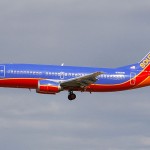Cabin pressure drops in Southwest plane after “fuselage rupture”
Cabin pressure dropped due to an "in-flight fuselage rupture" that hit a Southwest Airlines plane in mid-flight on Friday.
Flight 812 was cruising at an altitude of 36,000 feet when a part of the fuselage ripped open. Oxygen masks fell as the airline plummeted because of the loss of cabin pressure.
The airline pilot was able to control the descent and made an emergency landing at a military installation in Yuma, Arizona some 150 miles from Phoenix.
Some passengers and flight attendants reportedly passed out during the descent because of lack of oxygen. But there were no serious injuries suffered by the 118 people on board.
Authorities are still investigating what caused the rupture, but the Federal Bureau of Investigation has ruled out a terror attack.
The incident involving the 15-year-old Southwest Airlines aircraft was confirmed by the National Transportation Safety Board who is sending a team to Yuma. The Federal Aviation Administration is also looking at what happened.
Loss of cabin pressure ensues when the fuselage is cracked open because of lightning strikes, metal fatigue or small holes and cracks. Airlines are supposed to conduct periodic inspection to check the integrity of their aircraft.
Southwest Airlines had earlier settled for $7.5 million on charges that it flew planes which have not been inspected thoroughly for cracks in fuselage. About 200 Boeing 737 planes were inspected by the airline and concluded that they were safe to fly.
In July 2009, a Southwest Airlines flight to Baltimore had to make an emergency landing after a part of the cabin blew open, causing a sudden drop in cabin pressure.
